MAPilgrimMonument
CORNERSTONE LAYING, AUGUST 1907
From New England Craftsman, Vol. II, No. ?, :
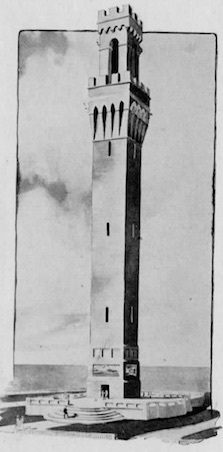
Pilgrim Monument, Provincetown
Laying the Corner-Stone of the Pilgrim Monument
at Provincetown August 20, 1907
No recent event has attracted more attention than the laying of the corner-Hne of the Pilgrim monument at Provincetown, Mass.. Aug. 20. The presence of the President of the United Stales, the Governor of Rusachusetts and many other notable persons gave an importance to the occasion which has rarely ever been reached at the laying of a corner stone of a public structure. The fact alone that the monument is intended to commemorate the first landing of the Pilgrims in this country gave the occasion a dignity of the highest importance but in addition to the thoughts suggested by the Pilgrims and their notable civil compact which was the beginning of the first government in the world where the governing power was derived from the governed; the President extended the scope of his address so it included many subjects vitally connected with the business integrity of the country and asserted his determination to punish dishonest methods and men and to "work heart and soul for the real and permanent betterment which will lift our democratic civilization to a higher level of safety and usefulness."
In appreciation of the importance of the occasion he said:
"It is not too much to say that the event commemorated by the monument which we have come here to dedicate was one of those rare events which can in good faith be called of world importance. The coming hither of the Puritan three centuries ago shaped the destinies of this continent, and therefore profoundly affected the destiny of the whole world."
With the same idea of the significance of the occasion. Governor Guild said: "This monument rises, a beacon to the mariner, because in this harbor American waters first embraced the ship which in a dissolute and corrupt age brought to Massachusetts not merely household goods, but as household gods the ideals of chastity among women and of honor among men; of a free government by a free people; of equality, of opportunity, and above all of ordered liberty under the law upon which men of their own race and men of other races who came after them have huilded not one State only, hut the United States of America."
Other notable speakers were: Ambassador Bryce, Congressman Lovering and Senator Lodge, whose able addresses have been published by the press throughout the land. It was intended that the speeches should follow the Masonic exercises, but a delay of one hour in the arrival of the train which conveyed the Grand Lodge made a change in the programme necessary. There were about seventy-five members of the Grand Lodge in attendance, among whom were: Most Worshipful J. Albert Blake, Grand Master; Right Worshipful [http://masonicgenealogy.com/MediaWiki/index.php?title=MAGLAWay Arthur T. Way, Deputy Grand Master; Right Worshipful Edward E. Graves, Senior Grand Warden; Right Worshipful David T. Remington, Acting Junior Grand Warden; Right Worshipful Charles H. Ramsay, Grand Treasurer; Right Worshipful Sereno D. Nickerson, Grand Secretary; Worshipful Melvin M. Johnson, Grand Marshal, and Worshipful George W. Chester, Grand Tyler. Twenty-three of the District Deputy Grand Masters wer present. There were also, as guests of the Grand Lodge, Brother Julius F. Sachse, Librarian of the Grand Lodge of Pennsylvania, and Wor. Brother Harry Hunt, Grand High Priest of the Grand R. A. Chapter oi Massachusetts.
The Grand Lodge, under escort oi Sutton Commandery of New Redford and attended by King Hiram's Lodge of Provincetown, marched to the site of the monument and conducted the ceremony of laying the corner-stone in accordance with the following programme:
- American Hymn, Keller. New Bedford Band.
- Request to Lay the Corner-Stone, By the President of the Pilgrim Memorial Association, J. Henry Sears, Esq.
- Response by the Grand Master.
- Reading of Selections from the Scriptures, By W. and Rev. William H. Rider, D. D., Grand Chaplain.
- Prayer by the Grand Chaplain.
- Hymn, To the Glory of Our Pilgrim Fathers, Sung by the Harvard Quartette.
(if List of Contents of
- Reading of List of Contents of Box, by the Grand Treasurer, R. W. Charles H. Ramsay.
- Application of the Jewels to the Corner-Stone.
- Libation of Corn, by the Deputy Grand Master, R. W. Arthur T. Way.
- Libation of Wine, by the Senior Grand Warden, R. W. Edward G. Graves.
- Libation of Oil, by the Junior Grand Warden, K. W. David T. Remington.
- Invocation by the Grand Chaplain.
- Presentation of Working Tools to Architect, Mr. Willard T. Sears.
- Address by R. W. William B. Lawrence.
- Proclamation by the Grand Marshal, W. Melvin M. Johnson.
When the Grand Master reached that part of the ceremony where he is required to spread the mortar on the foundation, after performing his duty, he requested President Roosevelt to assist in the ceremony,.the President cordially responded to the request of the Grand Master, and, taking the trowel in his hand, skilfully spread a portion of mortar on the foundation. The President was followed by Governor Guild and by J. Henry Sears, president of the monument association, in the same service. The formal address connected with the Masonic event was delivered by Right Worshipful William B. Lawrence. It was an able production, interesting in subject, scholarly in treatment and in perfect harmony with the dignity of the occasion. We regret that we are unable to give but a short extract from the address.
Brother Lawrence spoke in part as follows;
"Onthis spot we are today met together to lay, with Masonic ceremonies, the corner-stone of a fitting national memorial to that Mayflower Compact and the men who made it.
"But in the broader sense the Nation that pays this tribute is their grandest monument — and for that monument the Pilgrim Fathers themselves here laid the corner-stone, History tells us of no Masons among them, but it is safe to say that no band of men ever more fully expressed in their own lives the Masonic tenets of Brotherly Love, Relief, and Truth; or the four cardinal Masonic virtues of Temperance, Fortitude, Prudence and Justice. As these qualities were necessary to the earlier Masons to preserve their very existence, so they were necessary to the Pilgrims to preserve their State. In both cases these qualities were the elements of a great and uplifting human movement because they were in the character of the men who made it.
"In an essentially commercial age, when men are too often absorbed in the eager struggle for wealth: when our industrial prosperity advances by leaps and bounds; when combinations of wealth so created wield unprecedented power — and yet when liberty is to be taken for granted that many neglect political duty for private interest and think no shame of it — it cannot be too squarely emphasized than the Mayflower Compact came into being because the Pilgrim Fathers saw, and understood, and wisely feared, the disaffecting of selfish indifference of a very few among them. Thus they laid the cornerstone of American constitutional liberty, the first government in the world that derived its power from the consent of all governed.
"It has been unfortunate that the public mind should lose sight of the Pilgrim Fathers' connection with the Cape, and it is therefore ail the more an inspiring duty to lay the cornerstone of this monument. May it hereafter visualize that first small immigration of a noble hundred — the men whose first thought in making a government was of justice and equality; whose lirst safeguard was to prevent the license that comes whenever a single man considers himself a law unto himself and independent of the just and equal rights of others. This danger in one form or another we shall probably have always with us. It is the penalty of extreme power that the man who wields it prows unconsciously to feel himself superior to the laws that govern the less powerful. It is the curse of extreme weakness, that the man who is afflicted with it comes to believe in anarchy. The safety of the Pilgrim community lay in the fact that every individual did his part for the good of all — and in this thought lies also the safety the great nation in whose making they were so important a factor."
REDEDICATION, AUGUST 2007
From TROWEL, Summer 2007, Page 2:

Rededication of Province town's Pilgrim Monument
by Wor. William Rex McKinsey II
On August 20, 1907, President and Masonic Brother Theodore Roosevelt entered Provincetown Harbor on the Presidential Yacht Mayflower to a 21-gun salute from eight battleships lining his approach. The Navy sent ashore 1,500 marines to form two columns along the parade route. Arriving by train to perform a centuries-old ceremony for dedicating public and religious buildings were the Grand Master and over 100 other Masons.
What an incredible experience for the townsfolk of the little fishing village: an impressive day with grand speeches, honorary toasts, sumptuous dinners and dancing!
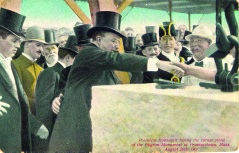
Antique picture postcard showing President Theodore Roosevelt
participating in laying the cornerstone in 1907.
That memorable 1907 event will be recreated this summer, and every Mason has an opportunity to participate in the once-in-a-lifetime occasion. Understanding the history and symbolism of cornerstone laying ceremonies will make the event even more meaningful.
Historic American Cornerstone Ceremonies
The ceremonies at Pilgrim Monument in 1907 recalled when George Washington, Past Master of Virginia's Alexandria Lodge No. 22, officially laid the cornerstone of the Capitol on September 18, 1793. The President officiated in full Masonic regalia and wore the apron given to him by his close friend and wartime comrade, the Marquis de Lafayette.
With each subsequent Capitol building expansion, a new cornerstone was laid with Masonic ceremonies. While Millard Fillmore was elected to Congress as a member of the Anti-Masonic Party, when he officiated as President at the cornerstone laying ceremonies at the Capitol, he asked the Grand Master of the District of Columbia to see that the stone was laid well. These ceremonies were repeated on September 18, 1932, and July 4, 1959. Masonic cornerstone laying ceremonies were used when dedicating other prominent Washington structures, including: City Hall (1820), Smithsonian Institution (1847), Washington Monument (1848), Steuben Monument (1870), and American University (1896).
The cornerstone of the Statue of Liberty in New York (1884) was also tried with Masonic working tools. Look around your town; you are sure to find cornerstones nearby attesting to the dedication of Masons to public works of stone and heart.
The Cornerstone Laying Ceremony
Until the development of steel-frame construction in the 20th century, most buildings were erected by stacking stone on stone. Each stage of a building's progress was marked with ceremonies, beginning with the first stone of the foundation being placed underground. The cornerstone was the first stone placed above ground level—it was generally a massive stone marking the northeast corner of the building. At the top of the building was the capstone.
The cornerstone of an edifice in ancient times was perfectly square, from which the remainder of the building could be plumbed, squared and leveled. It provided the builder a point of reference to ensure that the structure would be properly built. The cornerstone would later become the symbolic basis for Freemasons allegorical rituals exemplifying a common, reasonable and universal point from which good men could begin a journey founded on the practice of Brotherly Love, Relief and Truth.
The ceremonies for placing these stones were under the direction of the masons who erected the building, although the highest government officials participated, including the king or his representative.
During medieval times, stonemasons formed guilds to instruct their apprentices and protect their construction trade secrets as they traveled throughout Europe. Seventeenth century minutes of the Worshipful Company of Masons in London indicate that operative masons participated in special ceremonies at the laying of cornerstones and the dedication of public buildings.
These ceremonies were occasions for public celebrations and fairs, with a ritualistic blessing of the progress made on the construction of a cathedral or castle. The 5th Abbot of Vale Royal Abbey, Cheshire, England, recorded about 1338 that ". . . on the ides of August A. D. 1277 the aforenamed Edward, then most illustrious King of England, in an assembly of all the greatest people of the kingdom, with his own hands put the first stone in place . . ."
No one can say when special cornerstone ceremonies began. What is certain is that it is indeed an ancient custom. Cornerstone laying was so important in Biblical times that it appears throughout both the Old and New Testaments.
The Louvre has two terracotta cylinders recovered from the ruins of the city of Lagesh in what was southern Babylonia. Covered with cuneiform writing, these cylinders were foundation deposits to mark the construction of a temple built about 3,000 B.C. by Gudea, ruler of Lagesh. Some 2,500 years later, Zerubbabel laid the foundation of the Temple of the Lord, rebuilding the Holy House erected by Solomon. The scene described in Ezra 3:10-12, is both joyous and poignant, with the "young people" happily rejoicing and the "old men" tearfully remembering former glories.
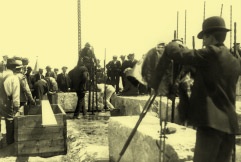
These celebrations could not have been times for "happily rejoicing" by all participants throughout history. Evidence suggests that deposits placed under the cornerstones, walls or posts of important buildings included gruesome offerings.
Some early civilizations thought buildings required supernatural protection, to defend against the spirit of the earth, air or nature, which would destroy what they erected unless a spiritual defender haunted the structure. As the gods were far stronger than men, the sacrifice to them would need to be significant. Hence rose that incredibly awful rite of foundation sacrifice in which human victims were walled up in the cornerstones; bound and thrown into a hollowed foundation, to die a miserable death of suffocation; or more mercifully crushed to death by a stone laid atop their trembling bodies.
Legendary accounts of human sacrifices in connection with buildings are found in many lands and times; from St. Columba burying St. Oran alive in the foundations of a monastery, to the walling-in of a child when building Castle Liebenstein. When Hiel, the Bethelite, built Jericho, we are told in I Kings 16:34, "He laid the foundations thereof in Abiram, his first born, and set up the gates thereof in his youngest son, Segub."
In Africa, Borneo and Polynesia, foundations have been laid on human victims, and even today, animal or fowl sacrifices are made in connection with the setting of the center poles of some tribes. In time, human victims were replaced with animals, and then gradually supplanted with the fruits of the earth. As the ritual celebrations evolved, to be meaningful, the participants needed to sacrifice something of value, the giving of which would testify to the love and veneration by which the giver held the Most High. Thus, corn, wine and oil — grain, grape and olive — or the 'coin of the realm' became the symbols of the ancient sacrificial rites.
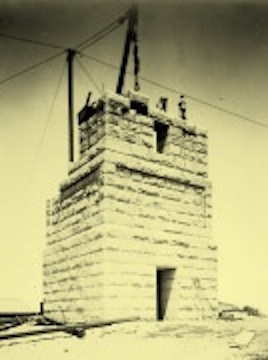
Corn, Wine and Oil
In ancient days the grapes in the vineyard, the olives of the grove and the grain of the field not only measured wealth but also facilitated commerce; so many skins of wine, so many cruses of oil, and so many bushels of grain were to tradesmen dollars and cents. Thus, the ancient craft received their wages, as a practical matter, in corn, wine and oil.
Oil was not only a food source. It provided light and was a toilet article. Mixed with perfume, it was used in anointment ceremonies and in preparing for ceremonial appearances. The "precious anointment, which ran down Aaron's beard" was doubtless made of olive oil mixed with perfumes as well as myrrh, cinnamon, galbanum and frankincense. The soothing effects of oil for medicinal uses were not lost on ancient nomadic tribes subject to injuries.
The corn of the Bible is not the corn we know, but more simply "grain." The principal grains of Old Testament days were barley and wheat, both of which the Jews cultivated. An ear of grain has been an emblem of plenty since the beginnings of mythology. Ceres, goddess of abundance, survives today in our cereals. The Greeks called her Demeter, a corruption of Gemeter, our mother earth. She wore a garland of grain and carried ears of grain.
Wine was scarcely less important than corn and oil to our ancient brethren. Vineyards were highly esteemed both as wealth and as comfort—the pleasant shade of the "vine and fig tree" was a part of ancient hospitality. Thorn hedges kept cattle from helping themselves to the grapes. The vintner frequently lived in a watchtower or elevated hut to keep sharp lookout that neither predatory man nor beast took his ripening wealth. Thus corn (representing nourishment and health), wine (emblematical of refreshment and prosperity) and oil (symbolizing light and peace) form important and necessary parts of the dedication and consecration of public buildings.
The Masonic cornerstone laying ceremony symbolizes giving the fruit of an individual's or community's labor to the greater good. Operative stonemasons hewed, squared and laid stones that formed the noble structures of antiquity and the soaring cathedrals of the Middle Ages. Their creations were more than mere piles of bricks and granite; they were symbols of man's persistent desire to establish order and harmony in the building of communities.
Working Tools
Stonemasons organized themselves into guilds or trade unions to pass on the knowledge of master masons to apprentices and to protect trade secrets as other guilds had done during the medieval period. These guilds were democratic and beneficent; electing officers, sharing responsibilities for the operation of the organization, teaching younger members their trades, and providing for their less fortunate members. This preceded the period of Enlightenment and influenced the religious separatists who signed the Mayflower Compact that expressed the idea of self-government that we still wrestle with today.
Modern Freemasonry serves as custodian of the symbolic use of the builder's tools and traditions, which it applies to the teaching of moral concepts and standards of conduct. The allegorical tools of Freemasonry pervade our lexicon. Squaring your actions, meeting on the level, and standing upright before God are all allegories of Masonic ritual.
In the Masonic cornerstone laying ceremony, the ancient working tools of the stonemason — the plumb, level and square — are applied to a stone. With the application of each tool, an officer attests that the craftsmen have done their work with great skill. These three elements have been used in dedicating buildings since the time of ancient Rome.
The ceremony ends with an oration about the symbolism attached to a leveled cornerstone, followed by prayer. Symbolically, Freemasons lay the cornerstones of public buildings to remind citizens of the purpose for which the edifices were erected. The ceremonial testing of the cornerstone by the square, level and plumb alludes to the testing of each Mason's virtues during his lifetime in preparation for "that house not made with hands, eternal in the heavens." Symbols in general, have been used throughout the ages to commemorate and testify to important undertakings: the sword given in defeat or presented as a token of status; the knife to seal a contract; and rice thrown at a wedding to secure fertility. While we cannot attribute the heightened interest in Freemasonry in recent years to the renewed pursuit of these truths, or to some movies, our personal journeys though Masonry present opportunities to ponder rituals that are relevant to our own trials.
The 2007 Centennial Event
The 1907 cornerstone laying at Provincetown's Pilgrim Monument heralded the beginning of its construction. The goal of the 2007 ceremonies is to hold a first-class parade and re-create the ritual originally performed by The Grand Lodge of Masons in Massachusetts, assisted by President Roosevelt and Massachusetts Governor Curtis Guild.
The square, level and plumb to be used in the upcoming centennial celebration at the Pilgrim Monument were made by Paul Revere. The allegorical cement of Brotherly Love will be spread by the original gavel used by Most Wor. John A. Blake, Governor Guild and President Roosevelt to lay the cornerstone of the Pilgrim Monument. These working tools are among the artifacts belonging to King Hiram's Lodge, Provincetown.
To properly celebrate this historic occasion, the Provincetown II will arrive in Provincetown Harbor at noon on August 20, 2007, with the Grand Lodge officers, other visiting brethren, dignitaries, Shriners, musicians, other parade units and the media on board. Traditional cannon shots will herald their arrival. A flotilla of vessels including the U.S. Coast Guard, Provincetown Harbormaster patrol and fireboats, Delaware's Tall Ship Kalmar Nyckel, dignitary boats from Plymouth and Dennis, as well as other vessels will line the approach from Long Point to the inner harbor. It will be a spectacular harbor event, so find your place early.
The parade will assemble on MacMillan Pier, where Masons will join local dignitaries, other participants and the U.S. Coast Guard Color Guard. The procession will then make its way up to the Monument where the Grand Lodge will perform the historic ceremony.
Pilgrim Monument and Museum
The Pilgrim Monument speaks to Provincetown being the first landing place of the Pilgrims and where the Mayflower Compact was signed, beginning an inevitable march toward self-government. The Mayflower Compact is a declaration of self-determination and radical thought that characterizes the history and people of Provincetown, which has a diverse and singular history, and has been home to sailors, pirates, fisherman, painters and authors for centuries.
The Monument grounds house the exceptional Province-town Museum, a repository of Provincetown's history, with a charming mix of old and new. The permanent exhibits retain the charm of an old-fashioned history museum. Exhibits highlight the arrival of the Mayflower Pilgrims, the town's rich maritime history, the early days of modern American theater in Provincetown, and the building of the Monument. There is also a re-creation of a 19th century sea captain's parlor and his quarters at sea; a diorama of the Mayflower Compact being signed aboard the Mayflower in Provincetown Harbor; and a scale model of the first theater of the Provincetown Players.
A special exhibit will highlight the "top 100" artifacts in the museum's permanent collection and will include a "treasure map" for visitors to find special selections displayed throughout the museum. Visitors may fill in their own favorites to complete the "top 100." Attendees will vote for their favorite artifacts and their lists will be tabulated for the Fall Closing Party. The www.pilgrim-monu-ment.org website has more information on this exhibit, summer programs and other exciting centennial events. As we go though our workaday lives, we rarely consider how future generations will perceive our times. The importance of museums to our lives is collecting and caring for our stories so the lessons are not lost. As we tell the story of the Pilgrims and their monument during this centennial, we also tell our story. Pilgrim Monument and Provincetown Museum is a custodian of that charge.
Overview and Importance of Pilgrims
On November 11, 1620, before they came ashore on Cape Cod, the Mayflower passengers made an agreement to join together as a "civil body politic." They also agreed to submit to the government which would be chosen by common consent, and to obey all laws made for the common good of the colony.
While the original document no longer exists, the text was included in a book about Plymouth Colony printed in 1622, known as Mourt's Relation. Governor William Bradford also copied it into his history of Plymouth Colony. The list of 41 signers first appeared in New England's Memoriall, published in 1669 by colonist Nathaniel Morton. No one knows whether or not he copied it from the original document, but it includes the names of all male heads of families, the free single men and three of the male servants.
The agreement (first called the Mayflower Compact in 1793) didn't get much official attention until after the American Revolution. Politicians struggling to establish the government of the newly created United States looked to the early Plymouth colonists for precedent. The Loyalists who supported peace with England pointed to their loyalty to King James and the laws of England. Pro-revolutionists saw the Compact as an example of pure democracy. John Quincy Adams described the agreement as "the only instance in human history of that positive, original social compact," which many believed to be the only legitimate source for government. Adams' view won out, and the Mayflower Compact has since been viewed as the cornerstone of American democracy. For more on the Plimoth Plantation, visit www.plimoth.org.
Attending the Rededication
While the cornerstone ceremony will take place on Monday, August 20, 2007, more special events are planned for that week. The opening reception on Sunday, August 19, will surely interest historians and schooner aficionados. The August 20th centennial will be a full day of pomp and ceremony.
Masons are invited to watch Grand Lodge enter the harbor and join the procession as it leaves the pier for the walk up the hill. Masons in morning suits or dark suits are invited to wear top hats, as did our 1907 brethren. The best views of the parade and ceremonies are from MacMillan Her and High Pole Hill on the Monument grounds.
There will be walking tours of the Pilgrim Monument and Provincetown Museum on Tuesday, August 21st. The tours will proceed to the Provincetown Art Association and Museum, Town Library and Town Hall to view their collections, and then to the Victorian Lodge Room of King Hiram's Lodge to see lodge artifacts and the murals attributed to Carl Wendte.
On Wednesday, King Hiram's Lodge will convene a spe cial communication. For more information, go to [www.kinghiramslodge.org www.kinghiramslodge.org].
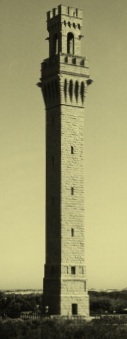
Credits and references: This article was written by Wor. Rex McKinsey, Master of King Hiram's Lodge. He writes:" I do not consider myself the author of this treatise, but an explorer and student of a fascinating period in history. I have relied heavily on numerous resources, articles and individuals and would like to acknowledge Grand Lodge Librarian Cynthia Alcorn, R. W. Thomas Pulkkinen, Bro. Robert Huke and M. W. Arthur Johnson; the staff and volunteers of the Cape Cod Pilgrim Memorial Association; King Hiram's Lodge Historian James Theriault and all those members who have contributed to our story; Gould's History of Freemasonry throughout the World; the Masonic Information Center and Service Associations; the definitive resource of the monument: The Pilgrims and their Monument by Edmond Carpenter, 1911; Pilgrim websites; Duane Steele, former editor and publisher of the Advocate; and articles by Eugene S. Hopp and Kermit A. Jacobson and others.